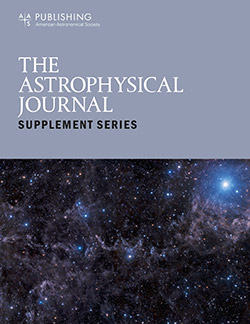通过对70颗气态行星的均匀透射巡天,探索哈勃太空望远镜WFC3 G141揭示系外行星大气种群趋势的能力
IF 8.5
1区 物理与天体物理
Q1 ASTRONOMY & ASTROPHYSICS
引用次数: 1
摘要
摘要利用哈勃望远镜的广角相机3 (WFC3)对70颗气态系外行星的大气进行了透射光谱分析。对于其中一半以上,我们在统计上检测到我们的检索归因于分子物种的光谱调制。其中,我们使用贝叶斯层次模型来搜索具有体积参数的化学趋势。我们利用提取的水丰度来推断大气的金属丰度,并将其与行星的质量进行比较。我们还进行了化学平衡反演,直接拟合大气金属丰度。然而,尽管以前的研究已经发现了质量金属丰度趋势的证据,但我们在我们的数据中没有发现这种关系。对于我们样本中较热的行星,我们发现了通过H -不透明的热解氢和水的证据。我们认为,在整个群体研究中普遍缺乏趋势可能是由于(i)哈勃太空望远镜WFC3 G141波段提供的光谱覆盖不足,(ii)整个群体缺乏简单的趋势,(iii)本研究的目标选择本质上是随机的,或者(iv)以上所有因素的综合。我们制定了如何从这些庞大的数据中学习,以确保将来可以利用JWST、Twinkle和Ariel等设施进行比较行星学研究。我们得出结论,需要更广泛的同时光谱覆盖以及更结构化的目标选择方法。本文章由计算机程序翻译,如有差异,请以英文原文为准。
Exploring the Ability of Hubble Space Telescope WFC3 G141 to Uncover Trends in Populations of Exoplanet Atmospheres through a Homogeneous Transmission Survey of 70 Gaseous Planets
Abstract We present analysis of the atmospheres of 70 gaseous extrasolar planets via transit spectroscopy with Hubble’s Wide Field Camera 3 (WFC3). For over half of these, we statistically detect spectral modulation that our retrievals attribute to molecular species. Among these, we use Bayesian hierarchical modeling to search for chemical trends with bulk parameters. We use the extracted water abundance to infer the atmospheric metallicity and compare it to the planet’s mass. We also run chemical equilibrium retrievals, fitting for the atmospheric metallicity directly. However, although previous studies have found evidence of a mass–metallicity trend, we find no such relation within our data. For the hotter planets within our sample, we find evidence for thermal dissociation of dihydrogen and water via the H − opacity. We suggest that the general lack of trends seen across this population study could be due to (i) the insufficient spectral coverage offered by the Hubble Space Telescope’s WFC3 G141 band, (ii) the lack of a simple trend across the whole population, (iii) the essentially random nature of the target selection for this study, or (iv) a combination of all the above. We set out how we can learn from this vast data set going forward in an attempt to ensure comparative planetology can be undertaken in the future with facilities such as the JWST, Twinkle, and Ariel. We conclude that a wider simultaneous spectral coverage is required as well as a more structured approach to target selection.
求助全文
通过发布文献求助,成功后即可免费获取论文全文。
去求助
来源期刊

Astrophysical Journal Supplement Series
地学天文-天文与天体物理
CiteScore
14.50
自引率
5.70%
发文量
264
审稿时长
2 months
期刊介绍:
The Astrophysical Journal Supplement (ApJS) serves as an open-access journal that publishes significant articles featuring extensive data or calculations in the field of astrophysics. It also facilitates Special Issues, presenting thematically related papers simultaneously in a single volume.
 求助内容:
求助内容: 应助结果提醒方式:
应助结果提醒方式:


